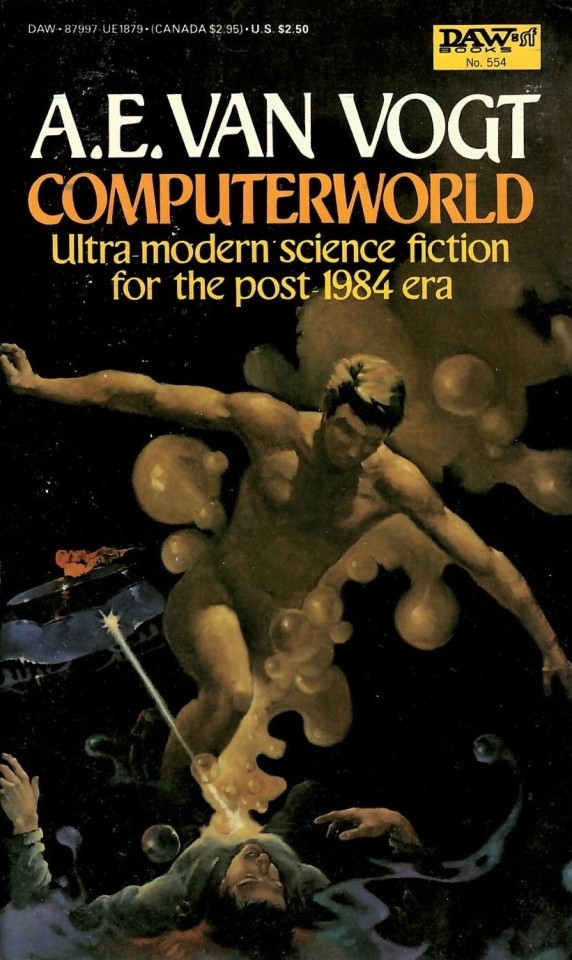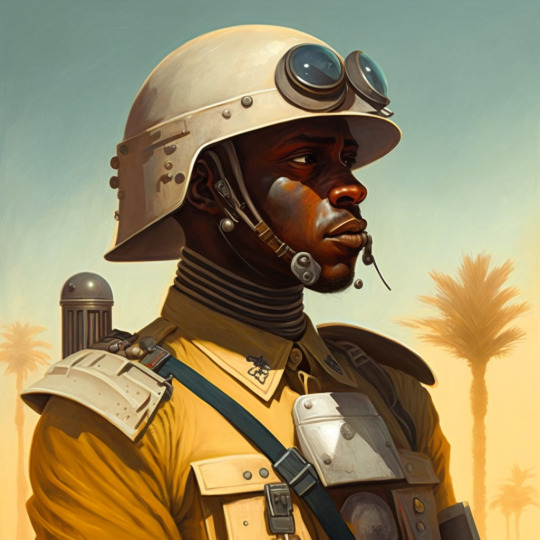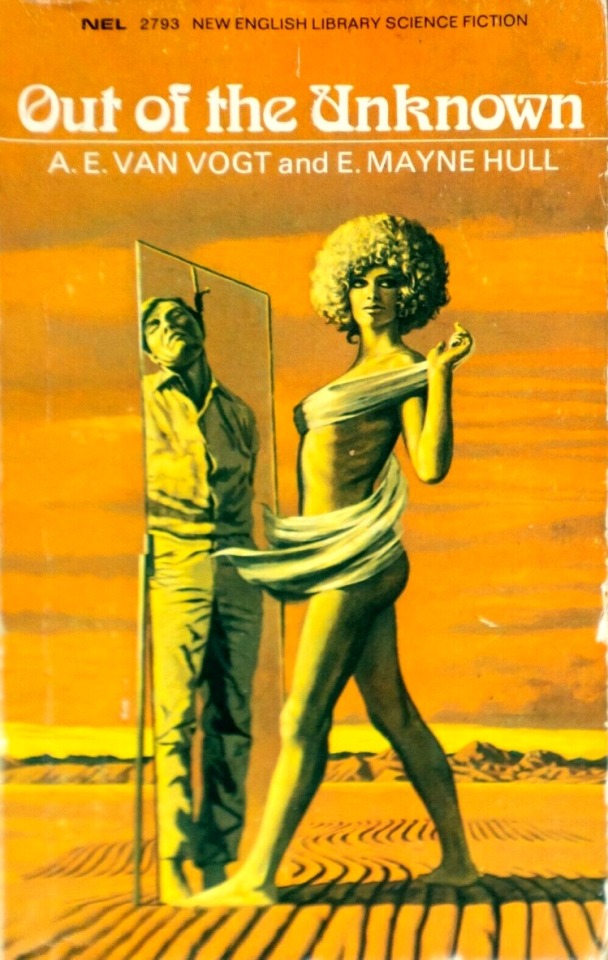#A. E. Van Vogt
Explore tagged Tumblr posts
Photo

Uncredited cover art detail for the 1972 German edition of A. E. van Vogt's Children of Tomorrow
560 notes
·
View notes
Text

Computerworld by A.E. van Vogt, cover by Michael Mariano (1983)
112 notes
·
View notes
Text

Art by Tim White for The Man with a Thousand Names by A. E. van Vogt (1975)
237 notes
·
View notes
Text

The Voyage of the Space Beagle - art by Jack Faragasso (1963)
#jack faragasso#60s sci-fi art#sci-fi novels#space art#a. e. van vogt#cover art#moon orbit#space exploration#panther books#sixties#1963
83 notes
·
View notes
Text

A book you very likely don’t have on your shelf #683
Cover by Sergio Macedo -- 1976
#1976#1970s#1970's#a. e. van vogt#spaceship#cover art#book cover#paperback#vintage paperback#science fiction#scifi#sci fi#sci-fi#ephemera
13 notes
·
View notes
Text
AI + the weapon shops





#futurism#artificial intelligence#midjourney#ai art#scifi#retrofuturism#retro scifi#space#cyberpunk#cyborg#robots#soldier#military#space force#spaceforce#A. E. Van Vogt#the weapon shop#afrofuturism
278 notes
·
View notes
Text

eerie_magazine_139 : Free Download, Borrow, and Streaming : Internet Archive
3 notes
·
View notes
Photo

3 notes
·
View notes
Text
I came across the idea of a "cortical-thalamic pause" in an old novel. The idea being that we take better, more effective action in our lives when we integrate our emotion centers and our reasoning centers. It was a NOVEL, mind you, but coming across the idea as a kid probably helped my life a lot.
A surprisingly useful summary from Quora :
Thalamus/Thalamic is here used as a shorthand for the lower brain functions, associated with feelings, sensing, pain, pleasure, instincts, bodily functions, etc. Massive sub-conscious parallel processing goes on there and responses are often immediate. Neo-Cortex/Cortical is the shorthand for the higher, more recently developed, brain functions, associated with conscious thinking, reasoning, language use, deliberate decision making, etc. It can do abstract thinking, but can't focus on more than a couple of things at the same time.
We easily get in trouble when we mix the two. Our ability to abstract is rather new and apparently a bit faulty. The cortex might construct a "meaning" for some lower level sensations which gives rise to faulty decisions. The thalamic system might launch instant action based on what was sketchy reasoning in the cortex. E.g. killing somebody because they have the wrong religious belief. The idea of the pause is basically to be conscious of the link between one's reactions and one's reasoning, and to make sure they're in sync. It doesn't have to be a literal pause in time, but it could be. It is an equivalent of "count to ten before you...".
If you were about to take impulsive physical action, the pause would allow you to think through the logic and implications of what you were about to do. The other way around, if you thought you just arrived at a logical, well reasoned conclusion, a semantic pause would allow you to notice what you actually feel about it, what your instincts tell you. Does it feel right? Does it work?
The primary ingredient is consciousness. Pay attention. Be aware. Examine everything that is there, including your own thoughts, your premises, your feelings, what you perceive. -- There are certain tools that are helpful. A consciousness of abstraction is vital. Simply being aware that there are many levels of abstraction between what really is there and what you put into words and thoughts. Not just being aware of that, but specifically examining the transition between a "thing" and its abstraction. At what point do some rays of light become a picture in your brain? At what point do you group it together with other tables you've seen, to identify it as a "table"? At what point does the word "table" lose its connection with the particular image you saw?
The objective is to take decisions and actions that are coherent, congruent and sane at all levels. The cortico-thalamic pause is a system check and a consistency check at and between multiple levels.
Learning to be less reactive is literally saving my life. I’m finally understanding that processing things is not the same as immediately forming a response to them. I can process without feeling pressed to formulate a reaction to what someone said or did or a situation that displeases me. Not that a quick head on your shoulders is necessarily a bad thing, but 9/10 taking a minute to just process could save you so much trouble
#psychology#general semantics#daniel kahneman#thinking fast and slow#a. e. van vogt#null-a#sf#good advice
11K notes
·
View notes
Text

Sketches by Wayne Douglas Barlowe of an alien by A. E. van Vogt, scanned from Barlowe's Guide to Extraterrestrials.
34 notes
·
View notes
Text


Charles Edward Cooke, A. E. van Vogt - The Hypnotism Handbook (1956)
15 notes
·
View notes
Photo

A.E. van Vogt and E. Mayne Hull - Out of the Unknown - NEL - 1970
#witches#outers#occult#vintage#out of the unknown#nel books#new english library#e. mayne hull#a.e. van vogt#van vogt#1970#fictious
18 notes
·
View notes
Text

Pendulum by A. E. van Vogt, cover by "Penalva" (Jordi Penalva) (1978)
83 notes
·
View notes
Text
'The Voyage Of The Space Beagle' Retains A Crown of Tarnished Glory
'The Voyage of the Space Beagle' may be worn around the edges but it still deserves the title of classic. #sf #scifi #books #bookreview
The Voyage of the Space Beagle (1950) by A. E. van Vogt is everything you expect from Golden Age SF. There are alien planets to discover, dangerous encounters with strange creatures, daring acts of bravery, and intrigue from unexpected quarters. While the story works as a space adventure are elements that are trying for modern readers. However, if you don’t look too deeply under the surface The…
0 notes
Note
Do you happen to know the origin of the fantasy trope in which a deity's power directly corresponds to the number of their believers / the strength of their believers' faith?
I only know it from places like Discworld and DnD that I'm fairly confident are referencing some earlier source, but outside of Tinkerbell in Peter Pan, I can't think of of any specific work it might've come from, 20th-c fantasy really not being my wheelhouse.
Thank you!
That's an interesting question. In terms of immediate sources, I suspect, but cannot prove, that the trope's early appearances in both Dungeons & Dragons and Discworld are most immediately influenced by the oeuvre of Harlan Ellison – his best-known work on the topic, the short story collection Deathbird Stories, was published in 1975, which places it very slightly into the post-D&D era, though most of the stories it contains were published individually earlier – but Ellison certainly isn't the trope's originator. L Sprague de Camp and Fritz Leiber also play with the idea in various forms, as does Roger Zelazny, though only Zelazny's earliest work is properly pre-D&D.
Hm. Off the top of my head, the earliest piece of fantasy fiction I can think of that makes substantial use of the trope in its recognisably modern form is A E van Vogt's The Book of Ptath; it was first serialised in 1943, though no collected edition was published until 1947. I'm confident that someone who's more versed in early 20th Century speculative fiction than I am could push it back even earlier, though. Maybe one of this blog's better-read followers will chime in!
(Non-experts are welcome to offer examples as well, of course, but please double-check the publication date and make sure the work you have in mind was actually published prior to 1974.)
#gaming#tabletop roleplaying#tabletop rpgs#dungeons & dragons#d&d#tropes#media#literature#religion#death mention
4K notes
·
View notes
Text

A book you very likely don’t have on your shelf #459
1963
#1963#1960's#1960s#cover art#book cover#paperback#vintage paperback#science fiction#scifi#sci fi#sci-fi#ephemera#a. e. van vogt
11 notes
·
View notes